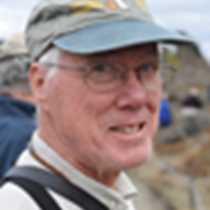Paradise Harbor & Palmer Station, Antarctica
In the morning the National Geographic Endeavour was moving southward through the Gerlache Strait, along the west side of the Antarctic Peninsula. Our Expedition Leader gave an early wake-up call. We struggled to the deck, gasped, and then rushed below for sunglasses and cameras. The view around us was beyond stunning: 360 degrees of snow and ice-covered slopes descending steeply from the mountains of the Antarctic Peninsula on our port side and Anvers Island to the starboard. And then we entered Paradise – the aptly named Paradise Harbor. We stopped to assist our Oceanites research team in counting blue-eyed shags nesting on a cliff near the abandoned Argentine research station of Almirante Brown. We then boarded Zodiacs to cruise through the glacial ice that has been dumped in myriad colors, sizes and shapes into the frigid water of the bay, thus completing its transit from land to sea.
The rest of the morning was spent basking in the incredible scenery around us as we moved to Arthur Harbor, on the south side of Anvers Island, to reach Palmer Station. The United States Antarctic Research Program (U.S. National Science Foundation) operates three research bases: Amundsen-Scott Station at the Geographic South Pole, McMurdo Base on the Ross Sea, and Palmer Station here on the Peninsula. Each ship carrying tourists in the Peninsula region is allotted one visit per year to the station; we were fortunate that this year’s visit fell during our trip. We were offered a tour of the facilities, a visit to the farthest-South gift shop, a chance to meet some of the support staff who remain year-around in the Antarctic, and a sampling of the famous Palmer Station brownies. We also visited nearby Torgerson Island, where a long-term study of the nesting of Adelie penguins has been conducted. In fact, we were part of the research. In order to determine the effects of visitation on the nesting success of the penguins, part of the island is open to visitation by tourists while the rest of the island is off-limits. The results: nesting success is as high on the visited side as it is in the unvisited control, showing that well-mannered tourists like us do not interfere with breeding of the penguins. A greater threat to the penguins comes from predatory brown skuas. We watched a skua flying between the sub-colonies distributed on snow-free patches over the island. Sure enough, it found its chance, quickly snatched an egg, and flew off to share its prize with its mate. Just above the landing at Torgerson Island we had an unusual view of all three species of brush-tailed penguins – gentoo, Adelie, and chinstrap – standing together on the snow.
Following our visits ashore some of the scientists and support staff from the station came aboard to share our evening cocktails and tell us something of life during extended stays in the Antarctic.
In the morning the National Geographic Endeavour was moving southward through the Gerlache Strait, along the west side of the Antarctic Peninsula. Our Expedition Leader gave an early wake-up call. We struggled to the deck, gasped, and then rushed below for sunglasses and cameras. The view around us was beyond stunning: 360 degrees of snow and ice-covered slopes descending steeply from the mountains of the Antarctic Peninsula on our port side and Anvers Island to the starboard. And then we entered Paradise – the aptly named Paradise Harbor. We stopped to assist our Oceanites research team in counting blue-eyed shags nesting on a cliff near the abandoned Argentine research station of Almirante Brown. We then boarded Zodiacs to cruise through the glacial ice that has been dumped in myriad colors, sizes and shapes into the frigid water of the bay, thus completing its transit from land to sea.
The rest of the morning was spent basking in the incredible scenery around us as we moved to Arthur Harbor, on the south side of Anvers Island, to reach Palmer Station. The United States Antarctic Research Program (U.S. National Science Foundation) operates three research bases: Amundsen-Scott Station at the Geographic South Pole, McMurdo Base on the Ross Sea, and Palmer Station here on the Peninsula. Each ship carrying tourists in the Peninsula region is allotted one visit per year to the station; we were fortunate that this year’s visit fell during our trip. We were offered a tour of the facilities, a visit to the farthest-South gift shop, a chance to meet some of the support staff who remain year-around in the Antarctic, and a sampling of the famous Palmer Station brownies. We also visited nearby Torgerson Island, where a long-term study of the nesting of Adelie penguins has been conducted. In fact, we were part of the research. In order to determine the effects of visitation on the nesting success of the penguins, part of the island is open to visitation by tourists while the rest of the island is off-limits. The results: nesting success is as high on the visited side as it is in the unvisited control, showing that well-mannered tourists like us do not interfere with breeding of the penguins. A greater threat to the penguins comes from predatory brown skuas. We watched a skua flying between the sub-colonies distributed on snow-free patches over the island. Sure enough, it found its chance, quickly snatched an egg, and flew off to share its prize with its mate. Just above the landing at Torgerson Island we had an unusual view of all three species of brush-tailed penguins – gentoo, Adelie, and chinstrap – standing together on the snow.
Following our visits ashore some of the scientists and support staff from the station came aboard to share our evening cocktails and tell us something of life during extended stays in the Antarctic.



